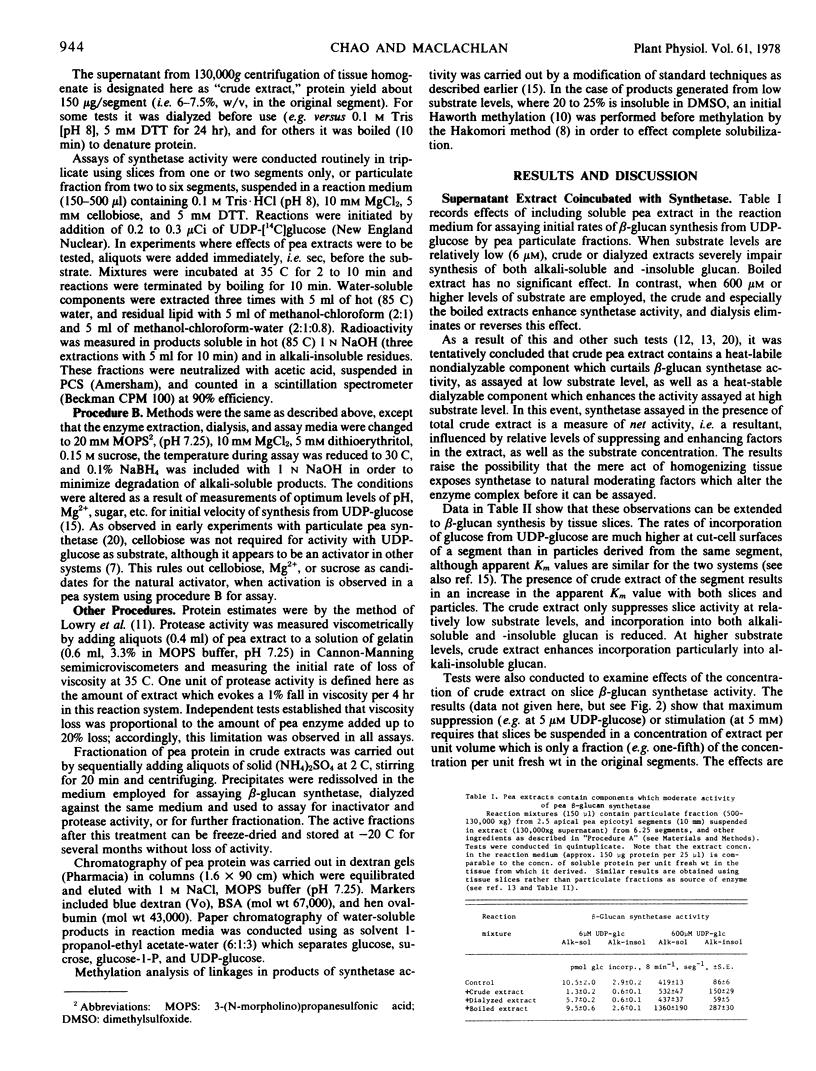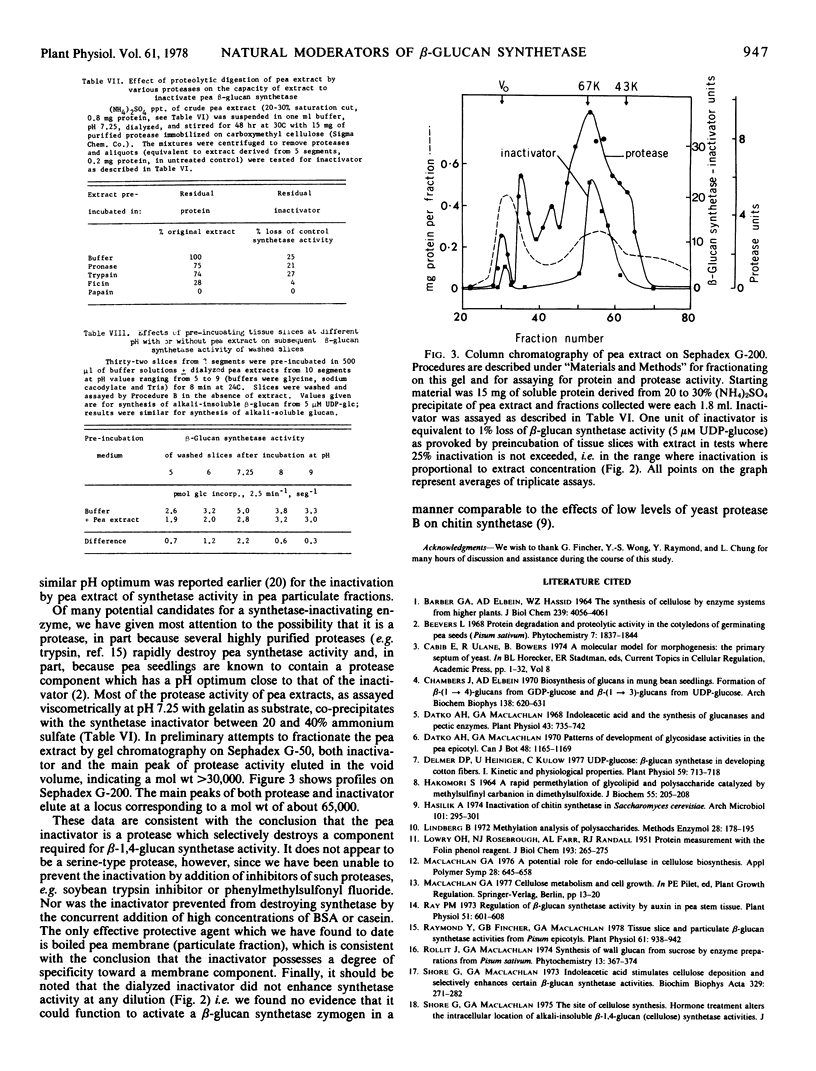Abstract
Homogenates of growing regions of the pea (Pisum sativum L.) epicotyl contain soluble factors (130,000g supernatant) which alter pea β-glucan synthetase activity, as assayed using the substrate UDP-glucose and either particulate fractions or tissue slices as source of enzyme. A heat-stable dialyzable component is present which enhances as much as 3-fold the synthesis of alkali-soluble and -insoluble products from millimolar levels of substrate. A heat-labile nondialyzable component is also present which suppresses synthesis. This component dominates (the net effect of total crude extract) when low (μm) levels of substrate are employed. Methylation analysis shows that both components primarily affect the proportion of β-1,4 rather than β-1,3 linkages which are synthesized. The enhancing factor increases Vmax of the synthetase system and only activates in the presence of high levels of substrate. The suppressing factor appears to inactivate the synthetase, since losses of product or substrate are not significant during brief incubation with extract, the factor acts progressively with time with a pH optimum, and it destroys activity during preincubation with particles or slices. It co-precipitates with a protease (gelatinase) at between 20% and 40%-saturated (NH4)2SO4, and it co-fractionates with a major component of total protease on Sephadex gel columns (G-200) with an elution volume corresponding to molecular weight 65,000. The concentrations of these factors are such that they could be natural moderators of synthetase activity in vivo if the two were ever brought in contact, and the inactivator could account for the lability of β1,4-glucan synthetase which occurs upon tissue homogenization.
Full text
PDF





Selected References
These references are in PubMed. This may not be the complete list of references from this article.
- BARBER H. A., ELBEIN A. D., HASSID W. Z. THE SYNTHESIS OF CELLULOSE BY ENZYME SYSTEMS FROM HIGHER PLANTS. J Biol Chem. 1964 Dec;239:4056–4061. [PubMed] [Google Scholar]
- Cabib E., Ulane R., Bowers B. A molecular model for morphogenesis: the primary septum of yeast. Curr Top Cell Regul. 1974;8(0):1–32. doi: 10.1016/b978-0-12-152808-9.50008-0. [DOI] [PubMed] [Google Scholar]
- Chambers J., Elbein A. D. Biosynthesis of glucans in mung bean seedlings. Formation of beta-(1,4)-glucans from GDP-glucose and beta-(1,3)-glucans from UDP-glucose. Arch Biochem Biophys. 1970 Jun;138(2):620–631. doi: 10.1016/0003-9861(70)90389-9. [DOI] [PubMed] [Google Scholar]
- Datko A. H., Maclachlan G. A. Indoleacetic Acid and the synthesis of glucanases and pectic enzymes. Plant Physiol. 1968 May;43(5):735–742. doi: 10.1104/pp.43.5.735. [DOI] [PMC free article] [PubMed] [Google Scholar]
- Delmer D. P., Heiniger U., Kulow C. UDP-glucose: Glucan Synthetase in Developing Cotton Fibers: I. Kinetic and Physiological Properties. Plant Physiol. 1977 Apr;59(4):713–718. doi: 10.1104/pp.59.4.713. [DOI] [PMC free article] [PubMed] [Google Scholar]
- HAKOMORI S. A RAPID PERMETHYLATION OF GLYCOLIPID, AND POLYSACCHARIDE CATALYZED BY METHYLSULFINYL CARBANION IN DIMETHYL SULFOXIDE. J Biochem. 1964 Feb;55:205–208. [PubMed] [Google Scholar]
- Hasilik A. Inactivation of chitin synthase in Saccharomyces cerevisiae. Arch Microbiol. 1974;101(4):295–301. doi: 10.1007/BF00455946. [DOI] [PubMed] [Google Scholar]
- LOWRY O. H., ROSEBROUGH N. J., FARR A. L., RANDALL R. J. Protein measurement with the Folin phenol reagent. J Biol Chem. 1951 Nov;193(1):265–275. [PubMed] [Google Scholar]
- Ray P. M. Regulation of beta-Glucan Synthetase Activity by Auxin in Pea Stem Tissue: I. Kinetic Aspects. Plant Physiol. 1973 Apr;51(4):601–608. doi: 10.1104/pp.51.4.601. [DOI] [PMC free article] [PubMed] [Google Scholar]
- Raymond Y., Fincher G. B., Maclachlan G. A. Tissue Slice and Particulate beta-Glucan Synthetase Activities from Pisum Epicotyls. Plant Physiol. 1978 Jun;61(6):938–942. doi: 10.1104/pp.61.6.938. [DOI] [PMC free article] [PubMed] [Google Scholar]
- Shore G., Maclachlan G. A. Indoleacetic acid stimulates cellulose deposition and selectively enhances certain beta-glucan synthetase activities. Biochim Biophys Acta. 1973 Dec 5;329(2):271–282. doi: 10.1016/0304-4165(73)90292-4. [DOI] [PubMed] [Google Scholar]
- Shore G., Raymond Y., Maclachlan G. A. The Site of Cellulose Synthesis: Cell Surface and Intracellular beta-1, 4-Glucan (Cellulose) Synthetase Activities in Relation to the Stage and Direction of Cell Growth. Plant Physiol. 1975 Jul;56(1):34–38. doi: 10.1104/pp.56.1.34. [DOI] [PMC free article] [PubMed] [Google Scholar]
- Spencer F. S., Shore G., Ziola B., Maclachlan G. A. Particulate glucan synthetase activity: generation and inactivation after treatments with indoleacetic acid and cycloheximide. Arch Biochem Biophys. 1972 Sep;152(1):311–317. doi: 10.1016/0003-9861(72)90220-2. [DOI] [PubMed] [Google Scholar]
- Tsai C. M., Hassid W. Z. Solubilization and Separation of Uridine Diphospho-d-glucose: beta-(1 --> 4) Glucan and Uridine Diphospho-d-glucose:beta-(1 --> 3) Glucan Glucosyltransferases from Coleoptiles of Avena sativa. Plant Physiol. 1971 Jun;47(6):740–744. doi: 10.1104/pp.47.6.740. [DOI] [PMC free article] [PubMed] [Google Scholar]
- Wang M. C., Bartnicki-Garcia S. Synthesis of beta-1,3-glucan microfibrils by a cell-free extract from Phytophthora cinnamomi. Arch Biochem Biophys. 1976 Jul;175(1):351–354. doi: 10.1016/0003-9861(76)90517-8. [DOI] [PubMed] [Google Scholar]
- Wong Y. S., Fincher G. B., Maclachlan G. A. Cellulases Can Enhance beta-Glucan Synthesis. Science. 1977 Feb 18;195(4279):679–681. doi: 10.1126/science.195.4279.679. [DOI] [PubMed] [Google Scholar]
- Wong Y. S., Fincher G. B., Maclachlan G. A. Kinetic properties and substrate specificities of two cellulases from auxin-treated pea epicotyls. J Biol Chem. 1977 Feb 25;252(4):1402–1407. [PubMed] [Google Scholar]


